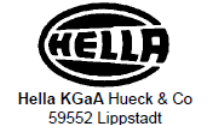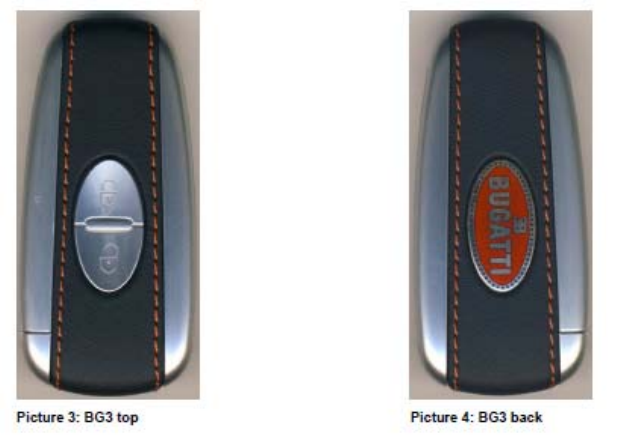HELLA and KGaA BG3 Radio Identification device User Manual
Hella KGaA Hueck & Co. Radio Identification device Users Manual
Users Manual

FCC ID: NBGBG3
IC: 2694A-BG3
USER MANUAL STATEMENT LETTER
HELLA KGaA HUECK & CO. will supply the following information to the reseller/distributor
(car manufacturer) dictating
what must be included in the end user’s manual for the commercial product:
1. Owner Manual USA
FCC ID: NBGBG3
This device complies with Part 15 of the FCC Rules. Operation is subject
to the following two conditions:
(1) This device may not cause harmful interference, and
(2) This device must accept any interference received, including interference that may
cause undesired operation.
Changes or modifications not expressly approved by the party responsible for
compliance could void the user's authority to operate the equipment.
FEDERALCOMMUNICATIONSCOMMISSIONINTERFERENCESTATEMENT
This equipment has been tested and found to comply with the limits for a Class B
digital device, pursuant to part 15 of the FCC Rules. These limits are designed to
provide reasonable protection against harmful interference in a residential installation.
This equipment generates, uses and can radiate radio frequency energy and, if not
installed and used in accordance with the instructions, may cause harmful
interference to radio communications. However, there is no guarantee that
interference will not occur in a particular installation. If this equipment does cause
harmful interference to radio or television reception, which can be determined by
turning the equipment off and on, the user is encouraged to try to correct the
interference by one or more of the following measures:
-Reorient or relocate the receiving antenna.
-Increase the separation between the equipment and receiver.
-Connect the equipment into an outlet on a circuit different from that to which the
receiver is connected.
-Consult the dealer or an experienced radio/ TV technician for help.
Owner Manual Canada
IC: 2694A-BG3
This device complies with Industry Canada license-exempt RSS standard(s).
Operation is subject to the following two conditions:
(1) This device may not cause harmful interference, and

(2) This device must accept any interference received, including interference that may
cause undesired operation.
Le présent appareil est conforme aux CNR d'Industrie Canada applicables aux
appareils radio exempts de licence. L'exploitation est autorisée aux deux conditions
suivantes:
(1) l'appareil ne doit pas produire de brouillage, et
(2) l'utilisateur de l'appareil doit
accepter tout brouillage radioélectrique subi, même si le brouillage est susceptible
d'en
compromettre le fonctionnement.
Basic construction element of the PLL identification device / remote control transmitter family
is the integrated circuit Delphi MegaCoderTx. This IC contains in a single package a
flash-programmable microcontroller, a transponder frontend with EEPROM and a
PLL-RF-transmitter. For passive entry / passive start functionality the system includes a
3-channel low frequency detector that serves for waking up the system and data reception
from the vehicle via a 125 kHz inductive link. It is implemented using a PCF7x52 integrated
circuit manufactured by NXP.
In active-entry-mode the buttons act as interface to the user. The microcontroller of
MegaCoderTx monitors the button signals, the power supply, encrypts and encodes the
transmit data and controls RF-telegram transmission.
The transponder is used for communication with the vehicle´s immobilizer system. It works
without battery supply taking its energy from the low frequency field generated by the vehicle.
Data is transferred from the transponder to the vehicle using damping modulation. Therefore,
the transponder does not emit any RF energy. The nominal working frequency of the
transponder system is 125 KHz. An integrated EEPROM serves as a storage device for
transponder- and transmitter-specific data. By pressing any of the buttons logic-high level is
applied to the inputs of the microcontroller waking up the system.
The PLL-part of IC1 uses a crystal oscillator circuit as frequency reference. The ratio of
transmit frequency and reference frequency is fixed to a value of 32. The PLL loop-filter is fully
integrated into the IC. An on-board resonant loop antenna is used to radiate the output signal
of the transmitter circuit. A low-pass filter connected between transmitter and antenna
suppresses harmonics of the transmitted signal. The transmitter´s power supply comes from a
lithium coin-cell battery CR2032. The nominal value of the supply voltage is 3 volt.
In passive mode three orthogonal antenna coils are used for detection of the vehicle´s 125
KHz low frequency signal. Further processing of the LF signal is done by NXP PCF7x52
integrated circuit. The LF detector of the PCF7x52 works in a passive way, it does not emit any
RF energy.